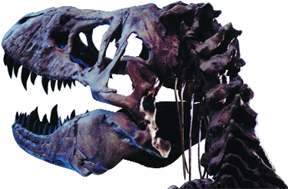 Tyrannosaurus
rex at age 14 may have been a wee 1,500-pound juvenile, but it then underwent
a massive teenage growth spurt to put on its bulk, according to new research
that maps out the life of T. rex from toddler to old age.
Tyrannosaurus
rex at age 14 may have been a wee 1,500-pound juvenile, but it then underwent
a massive teenage growth spurt to put on its bulk, according to new research
that maps out the life of T. rex from toddler to old age.New research based on growth ring counts from the bones of Tyrannosaurus rex shows that the dinosaur put on the bulk of its mass during its teenage years and then died shortly after its growth spurt. Image courtesy of University of California Museum of Paleontology.
Gregory Erickson of Florida State University and his colleagues used growth ring counts from 60 bones of four related tyrannosaurid species, along with size estimates of specimens between the ages of two and 28, to compile a growth curve. This curve, published in the Aug. 16 Nature, depicts T. rex’s developmental history and identifies the point at which T. rex grew most rapidly.
Between 14 and 18 years old, T. rex was packing on as much as 5 pounds per day, and “growing three to six times faster than its ancestors,” Erickson says, making for one hungry teenager. “Tyrannosaurids had a long childhood for a dinosaur,” says Thomas Holtz, a vertebrate paleontologist at the University of Maryland.
At maturity, the T. rex reached a hefty 11,000 pounds or more, and lived to be about 30 years old. Sue, the oldest T. rex specimen known, provided the clues to this age limit with her arthritis and broken bones, Erickson says. “She’s a real train wreck. That suggests she wasn’t going to live much longer.”
“These dinosaurs did not live particularly long after they had stopped growing,” Holtz says. In contrast, comparably sized modern mammals, such as elephants, rhinos and hippos, live to 50, 60 or 70 years old, he says. “T. rex reached its larger size by growing faster during its growth spurt, rather than by having a longer lasting growth spurt.”

